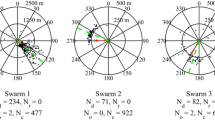Summary
-
1.
Honey bee swarms exercise considerable care when selecting a nest site. One nest site variable evaluated by bees is cavity volume.
-
2.
The volume distribution of natural nests (Fig. 1) has a wide range (12 to 4431 observed), but most nest volumes are clustered in the 20- to 100-1 subrange. The modal volume is approximately 351. This distribution reflects a process of volume selection among potential nest cavities when a swarm chooses its nest site. For example, swarms prefer 40-1 to 10 and 100-1 nest cavities. In nature, the volume-selection process operates primarily by rejecting undersized cavities, but also by rejecting oversized cavities.
-
3.
The observed limit in resolution power of volume perception was discrimination between cubes differing by 151.
-
4.
A swarm's preference in nest cavity volume is independent of swarm size.
-
5.
A scout bee's inspection of a nest site spans approximately 40 min. During this time a scout spends, most of her time at the nest site, engaged in numerous brief inspections inside and outside the nest cavity. When inside a cavity, a scout's principal behavior is rapid walking about the cavity's inner surfaces. The pattern of walking movements over successive interior inspections shows (1) a general progression from walking mostly near the entrance to walking deeper inside the cavity, and (2) a tendency to traverse different regions of the cavity's interior surface on different inspections.
-
6.
Honey bees can measure cavity volume if at least one of two conditions is fulfilled: (1) the cavity interior is well illuminated, or (2) the cavity's inner surfaces can be completely traversed by walking. The natural conditions for volume perception are probably low (<0.5 lux) cavity illumination, but traversable inner surfaces. The importance of walking to volume perception was demonstrated by manipulating scout bees' perceptions of a cavity's volume by varying the amount of walking required to move between points inside the cavity. The hypothesis is presented that scouts measure the volumes of dimly illuminated cavities by integration information on the distances and directions of walking movements made inside the cavity.
Similar content being viewed by others
References
Autrum, H., Seibt, U.: Die Dunkeladaptation des Bienenauges. Naturwissenschaften 52 566 (1965)
Bisetzky, A.R.: Die Tänze der Bienen nach einem Fuβweg zum Futterplatz. Z. vergl. Physiol. 40, 264–288 (1957)
Burgett, D.M., Morse, R.A.: The time of natural swarming in honey bees. Ann. Entomol. Soc. Amer. 67, 719–720 (1974)
Duelli, P.: Distanzdressuren von getragenen Ameisen (Cataglyphis bicolor Fabr., Hymenoptera, Formicidae). Rev. suisse Zool. 83, 413–418 (1976)
Frisch, K. von. Gelöste und ungelöste Rätsel der Bienensprache. Naturwissenschaften 35, 12–23, 38–43, (1948)
Frisch, K. von: The Dance Language and Orientation of Bees. Cambridge, Mass. Harvard University Press 1967
Heran, H., Lindauer, M.: Windkompensation und Seitenwindkorrektur der Bienen beim Flug über Wasser. Z. vergl. Physiol. 47 39–55 (1963)
Lindauer, M.: Schwarmbienen auf Wohnungssuche. Z. vergl. Physiol. 37, 263–324 (1955)
Lindauer, M.: Communication among Social Bees. Cambridge, Mass. Harvard University Press 1961
Lindauer, M.: Kompaßorientierung. Ergebn. Biol. 26 158–181 (1963)
Lindauer, M., Nedel, J.O.: Ein Schweresinnesorgan der Honigbiene. Z. vergl. Physiol. 42, 334–364 (1959)
Lindauer, M., Schricker, B.: Über die Funktion der Ocellen bei den Dämmerungsflügen der Honigbiene. Biol. Zbl. 82, 721–725 (1963)
Mitchell, C.: Weights of workers and drones. Amer. Bee J. 110, 468–469 (1970)
Schricker, B.: Die Orientierung der Honigbiene in der Dämmerung. Z. vergl. Physiol. 49, 420–458 (1965)
Seeley, T., Morse, R.A.: The nest of the honey bee (Apis mellifera L.). Insectes Sociaux 23, 495–512 (1976)
Simpson, J.: The amounts of hive-space needed by colonies of European Apis mellifera. J. Apic. Res. 8, 3–8 (1969)
Simpson J.: The influence of hive-space restriction on the tendency of honeybee colonies to rear queens. J. Apic. Res. 12, 183–186 (1973)
Author information
Authors and Affiliations
Additional information
Dedicated to Professor Karl von Frisch on the occasion of his 90th birthday
Rights and permissions
About this article
Cite this article
Seeley, T. Measurement of nest cavity volume by the honey bee (Apis mellifera). Behav Ecol Sociobiol 2, 201–227 (1977). https://doi.org/10.1007/BF00361902
Received:
Published:
Issue Date:
DOI: https://doi.org/10.1007/BF00361902




